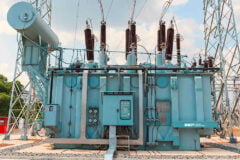N–PE loop resistance
Up-to-date test instruments, with built in modern electronics, can measure loop resistance even between the neutral N and protection PE conductors in spite of possible high currents in the neutral conductor. The current, which is driven by phase voltages through different linear and non-linear loads, causes voltage drops of extremely irregular (non sine wave) shape.

The voltage drops interfere with the test voltage and thereby disturb the measurement. Internal test voltage (approx. 40V, AC, <15 mA) is used, as there is no mains voltage between neutral and protection conductors.
Used test instrument Eurotest 61557 uses special (patented) measurement principle to filter the test signal and therefore assures correct measurement results.
What can we deduce from the measurement?
The following conclusions can be reached on the basis of the measurement result:
- Type of used protection conductor connection (TN, TT or IT-system)
- Earth Resistance value for TT-system
- In case of TT or TN-system, the result is quite similar to the Fault Loop
Resistance value, this is why the test instrument can also calculate the Fault Loop Prospective Short circuit current.
Generally about the measurement principle
As there is no mains voltage between the N and PE terminals which could be used as a test voltage the instrument must generate an internal one. This voltage may be either DC or AC. Used instrument uses AC test voltage, measurement is done following the U-I method according to the figure below.


Result = Ut / It = RN-PE
Where:
- Ut – Test voltage measured by the V-meter.
- It – Test current measured by the A-meter.
- RN-PE – Resistance of N-PE loop.
1. Measurement of N–PE loop resistance in TN-system
The test instrument measures the resistance of the neutral and the protection conductors from the power transformer to the measurement site (the loop is marked with a bold line on upper figure).
The test result in this case is quite low (maximum a couple of ohms), showing that a TN-system is involved.


Result 1 = RN + RPE
Result 2 = Ipsc = 230V × 1,06 / (RN + RPE)
Where:
- RN – Resistance of neutral conductor (marked with bold line)
- RPE – Resistance of protection conductor (marked with bold dotted line)
- Ipsc – Prospective short circuit current of fault loop
2. Measurement of N–PE loop resistance in TT-system
The test instrument measures the resistance in the following loop – Neutral conductor from power transformer to measurement site (mains outlet), protection conductor from the mains outlet to earth electrode and then back to the power transformer via soil and the transformer’s earthing system (the loop is marked with a bold line on the figure 3 below).
The test result in this case is quite high (in excess of ten ohms), showing that a TT-system is involved.


Result 1 = RN + RPE + RE + RO
Result 2 = Ipsc = 230V × 1,06 / (RN + RPE + RE + RO)
As it could be presumed, that resistance RE is much higher than the sum of all other resistances, the following can be noted:
Result 1 ≈ RE
Result 2 = Ipsc = 230V × 1,06 / RE
Where:
- RN – Resistance of neutral conductor from power transformer to measurement site (mains outlet)
- RPE – Resistance of protection conductor from the mains outlet to earthing electrode
- RE – Earth resistance of protection earth electrode
- RO – Earth resistance of transformer’s earthing system
- Ipsc – Prospective short circuit fault loop current
3. Measurement of N–PE loop resistance in IT-system
As can be seen from the Figure 4, there is no hard wired connection between the neutral and protection conductor in an IT-system. The test result is therefore very high (it can even be out of display range), showing that an IT-system is involved.


Reference // Measurements on electric installations in theory and practice by Metrel











Sometimes I measured much higher R(loop) than R(n-pe) (about 2 times higher).
The question is: how to be sure that R(loop) is not to high when I’m measuring R(n-pe) because I don’t want to RCD trips out?